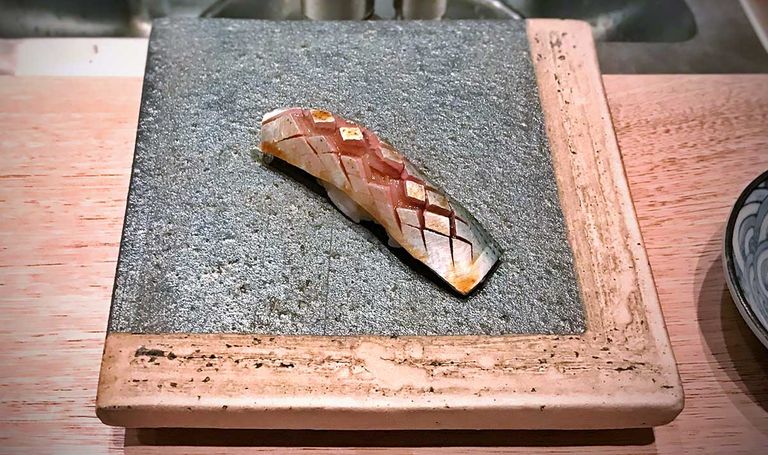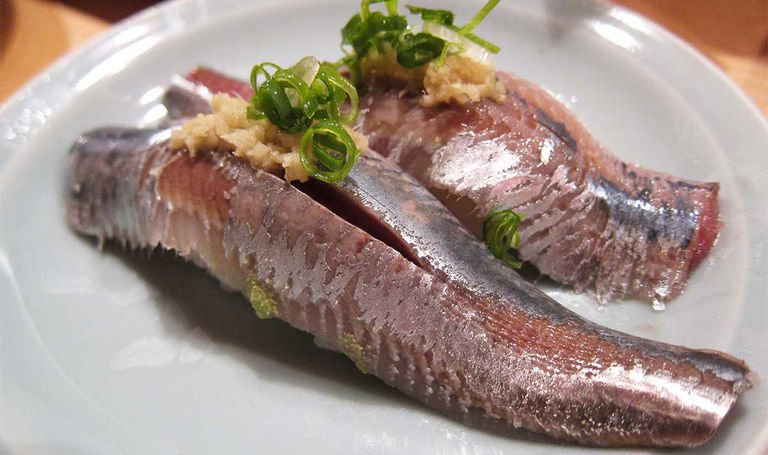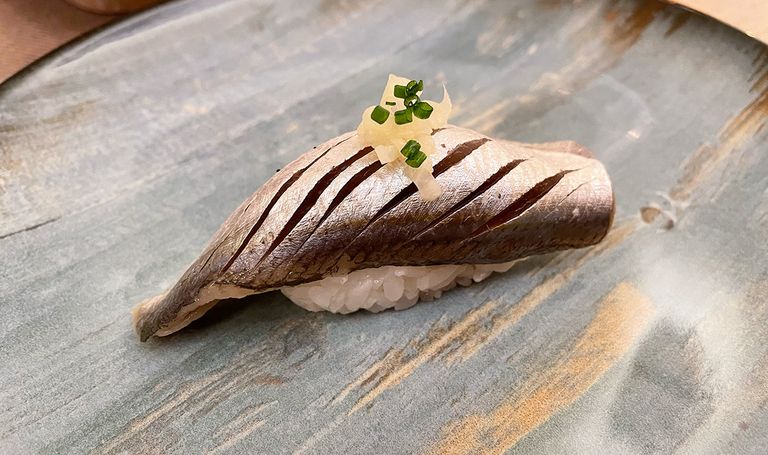Iwashi Sushi
A Comprehensive Overview of Sardine, Round Herring, or Anchovy in Japanese Sushi Cuisine
イワシすし 、 鰯(鰛・鰮)寿司 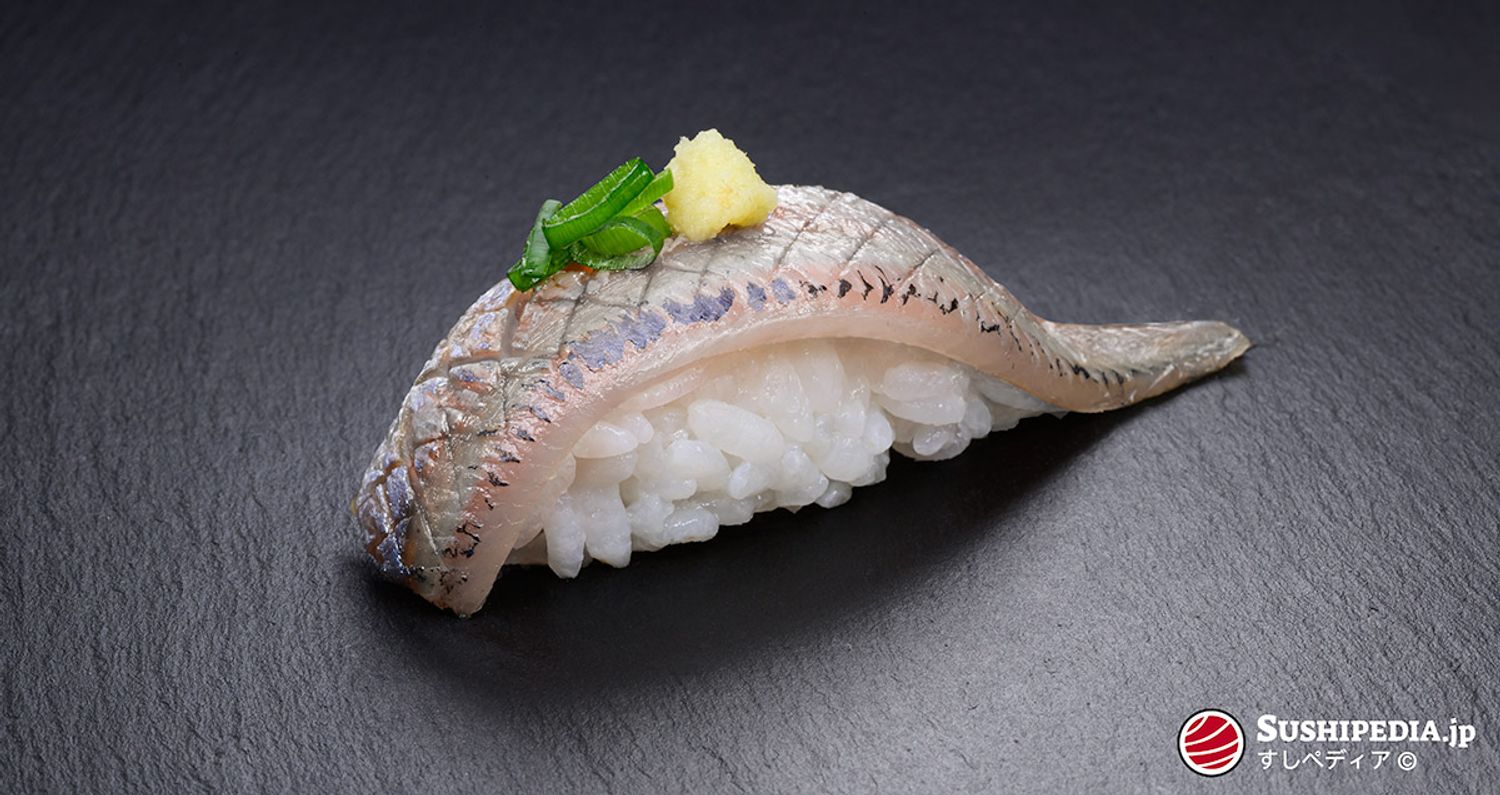
What is Iwashi?
In Japan the collective term iwashi (鰯・鰛・鰮) refers to a group of fishes belonging to the families of Clupeidae, Dussumieriidae and Engraulidae. Within this generic term, a distinction is made between three types. Those types are the pacific pilchards or sardines, round herrings and anchovies. These three groups are caught in large quantities and are important not only for fresh fish but also for the processing industry.
Iwashi for Sushi or Sashimi
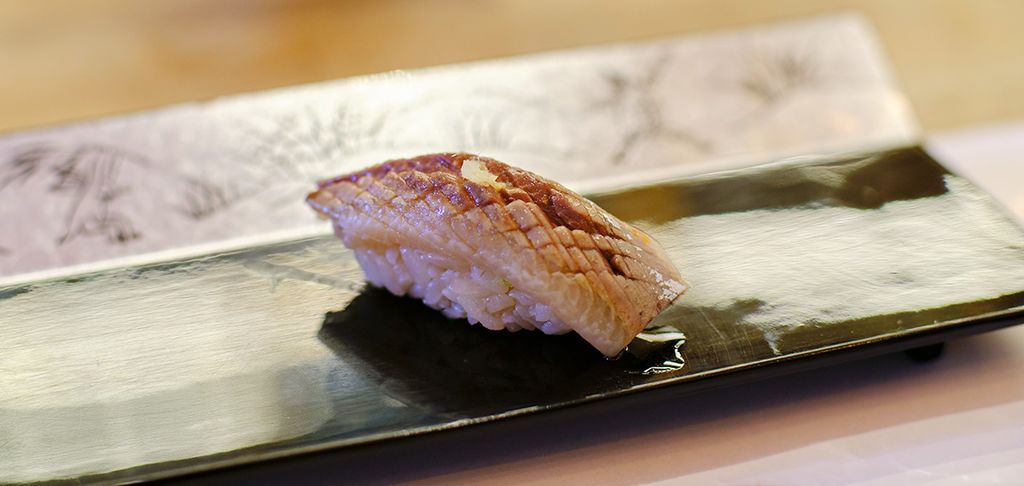
SushiPedia. Iwashi Sushi Nigiri on Omakase Menu. All rights reserved ©
The fish of the iwashi group are considered fragile, which must be processed carefully and quickly. Since its meat decomposes rapidly, it develops an unpleasant odor early after being caught and is therefore only available in limited quantities in sushi or sashimi quality. To maintain freshness, iwashi is either soaked in 3 to 5 percent salt water or previously sprinkled with salt and then placed in a mixture of ice water and vinegar. The osmotic effect of the salt solution has a slightly preservative effect, reduces the odor and maintains the shiny skin surface characteristic of iwashi.
With plump in-season iwashi, the fatty layer in between the skin and the flesh is amazingly thick. Despite that, it neither smells fishy nor tastes greasy.
Jiro Ono, Sushi Chef [1]
Ginger and green onions are suitable as a garnish. Besides the taste component, ginger also has a neutralizing effect on the smell. Especially fresh specimens harmonize very well with wasabi alone. In upscale sushi restaurants, ginger and spring onions are sometimes pressed into a paste, refined individually and placed on top of the nigiri that is coated with soy sauce. If iwashi is prepared as sashimi, soy sauce mixed with ginger is very suitable.
Best Season
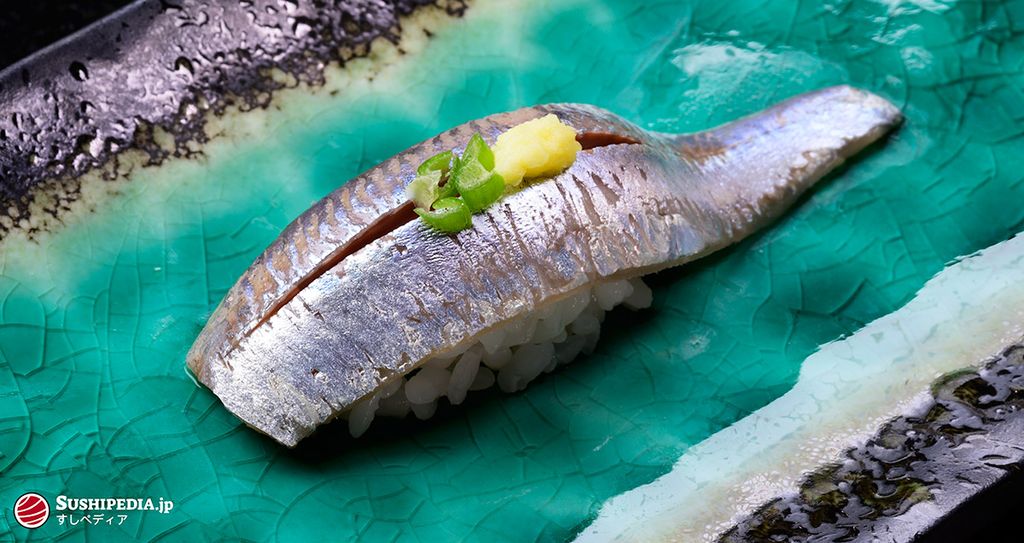
SushiPedia. Sardine Nigiri Sushi with Accompaniments on Ceramic Plate. All rights reserved ©
The spawning times of maiwashi depend on the region and population, therefore no exact season can be determined for sardines from the group of ma iwashi. In Japan, the months from June to October are traditionally considered to be the tastiest time of year for Japanese sardines. The spawning season of the European sardine (yōroppa maiwashi) also varies considerably by region and population, with the main fishing season beginning in late spring and ending in late summer. Iwashi caught between spring and summer are also considered particularly tasty and are called baiu iwashi (rainy season) or nyuubai iwashi (beginning of the rainy season). Urume iwashi is caught all year round, but it is said that the best season is from winter to early spring, when the fish have become fattier. Katakuchi iwashi migrates from the East China Sea to the coastal region of Taiwan to spawn in late winter and early spring. Therefore, summer is considered the best season for katakuchi iwashi.
Types of Iwashi
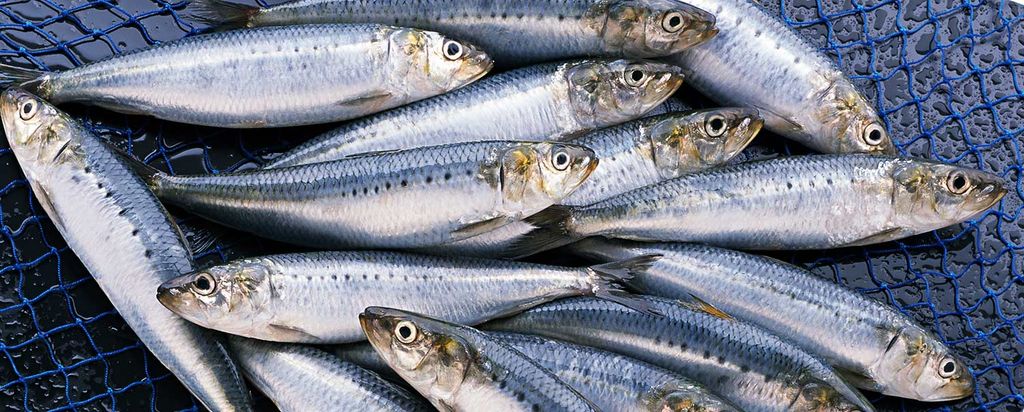
Non-disclosed author. Fresh Fish and Sea Food. All rights reserved ©
Maiwashi (Japanese Sardine)
The type of iwashi most commonly used in Japanese cuisine is the Japanese sardine, known in Japanese as maiwashi 真鰮, literally “real sardine”, after which its relatives are also named. Of all the types of iwashi, it is most commonly used in the preparation of sushi.
The Japanese sardine (Sardinops sagax melanostictus) is a subspecies of the Pacific sardine (S. sagax). It is found in the Indo-Pacific and East Pacific Oceans. It is characterized by specific regional names, some of which refer to its subspecies, such as the Australian sardine (S. s. neopilchardus), the Californian sardine (S. s. caeruleus) and the South African sardine (S. s. ocellatus). Accordingly, all representatives of this species have the term maiwashi in their Japanese name.
The Pacific sardine lives in large shoals near the coast. Juveniles feed on zooplankton, adults mainly on phytoplankton.
Urume Iwashi (Red-Eye Round Herring)
Urume Iwashi 潤目鰯, known as Red-Eye Round Herring in English, occupies an important place in the Japanese culinary landscape. This small fish species, which is characterized by its shiny body and its ability to live in large schools, is not only a staple of Japanese cuisine, but also an important component of various traditional dishes. Urume iwashi is prized for its intense flavor and variety of preparation options, from fresh to dried to fermented. This fish, which is found in abundance in the surrounding marine areas of Japan, plays a central role in everyday Japanese cuisine. It is often found dried and strung on a skewer as urume iwashi no mezashi. This is a traditional Japanese method of preparing small fish by placing them on bamboo or straw skewers by the eyes and lower jaw after salting and then air drying. This method preserves the fish and gives it a special texture and intense flavor. Mezashi is typically grilled and enjoyed as a tasty snack or accompaniment to rice dishes, where the crispy skin and tender flesh are particularly appreciated.
Urume iwashi live in tropical and temperate waters all over the world, even outside Japan. They swim in shoals near the surface of the sea and feed mainly on plankton.
Katakuchi Iwashi (Japanese Anchovy)
The katakuchi iwashi 片口鰯, scientifically known as Engraulis japonicus, is a species of anchovy found in the coastal waters of Japan and other parts of the Pacific. This small but ecologically and culinary important fish species is characterized by its shiny silver body and the typical slender shape that is characteristic of anchovies. Katakuchi Iwashi plays a central role in Japanese cuisine, both as a side dish and as the main ingredient in various traditional dishes. Due to their rich, umami-influenced flavor, these fish are particularly popular in fermented products and as a base for fish sauces used as a condiment.
Only particularly fresh and large specimens are suitable for sushi and are highly prized for their good taste. A large proportion of the katakuchi iwashi landed is often industrially processed into canned or dried fish. Young or immature fish fry are also known as shirasu しらす and are processed into chirimen jako ちりめんじゃこ.
Iwashi in Japan
In Japan, October 4 has been the official sardine day since 1985 (イワシの日). The day was created by the Iwashi Promotion Association (いわし普及協会) with the aim of encouraging the acceptance of sardines as a cheap and tasty fish. In Japanese, the date 4 October is written as 10月4日. This notation lends itself to a linguistic play on words, as the numbers 1, 0 and 4 can phonetically correspond to the sounds i, wa and shi respectively. Consequently, “10月4日” is reminiscent of the word “iwashi”, creating a pun that humorously links the date to the term for “sardine” [2].
Characteristics & Ecology of Iwashi
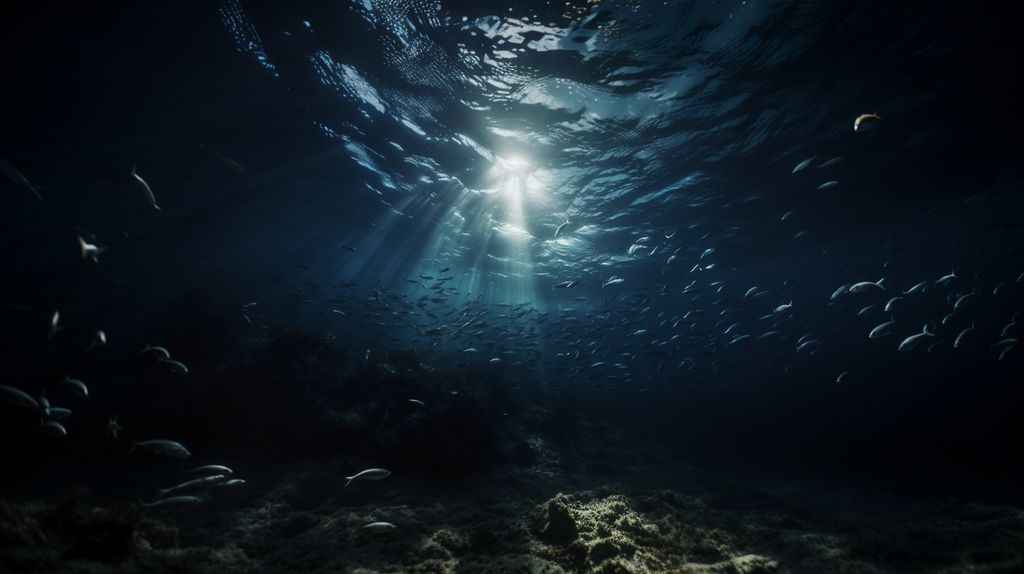
SushiPedia. School of Sardines Under Sunlight. All rights reserved ©
Iwashi are a group of small pelagic fish found in many marine areas around the world. These fish are particularly known for their schooling behavior, which helps them to escape predators. They generally prefer temperate to subtropical waters. They are found in large parts of the Pacific, the Atlantic, the Mediterranean and the North Sea. Living conditions depend on various factors, including water temperature, salinity, oxygen content and food availability. The ideal areas are those where upwelling currents bring nutrient-rich water from deeper layers to the surface.
The shoaling behavior of these fish species is a remarkable feature. They move in large, tightly packed groups that can consist of thousands of individuals. This behavior is more like a moving fluid that alternately concentrates in the center and then disperses. This behavior has several advantages:
- Protection from predators: By swimming in shoals, they reduce the likelihood of a single individual being seized by predators. The large numbers and close formation of the swarm can confuse and deter predators.
- Foraging efficiency: Shoals can move through the water more effectively and locate food sources. This allows sardines to search large areas for food and maximize food intake.
- Social interaction: Shoaling behavior also facilitates social interaction, which is important for reproduction and survival of the species.
The dynamics within such a swarm are complex. Each individual in the swarm reacts to the movements of its immediate neighbors, resulting in a coordinated movement of the entire swarm. These movements are often synchronized and can change rapidly, giving the swarm a fluid and almost choreographed appearance.
Economy of Iwashi
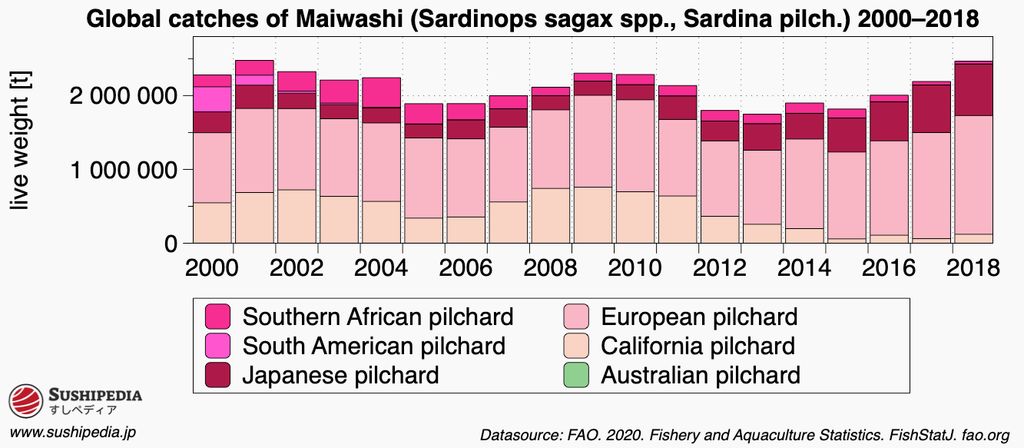
SushiPedia. Global Maiwashi catch statistics 2000-2018. All rights reserved ©
In the years from 2000 to 2018, the Japanese sardine accounted for an average of 21 percent of the global catch of the “maiwashi group”. The share of the European sardine was 54 percent. Maiwashi is mainly used for the production of processed products up to the production of fish meal, only a small percentage is used as fresh fish.
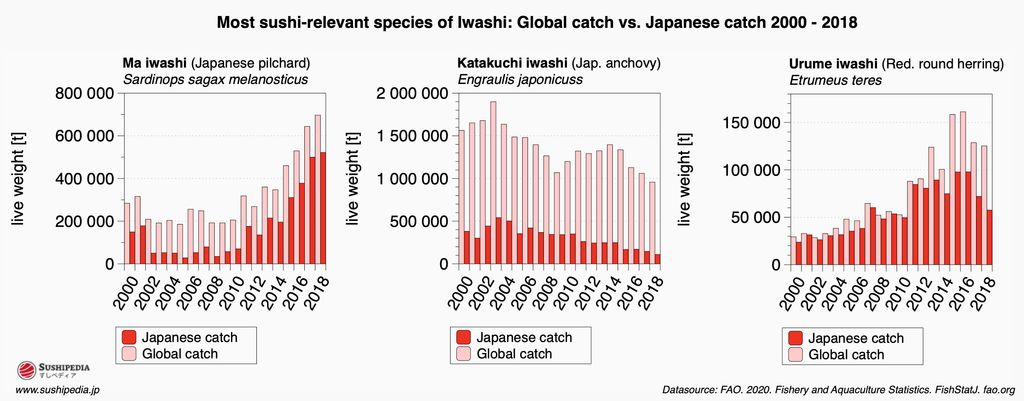
SushiPedia. Comparative Analysis of Global and Japanese Iwashi (Sardine) Catches Relevant to Sushi Production (2000-2018). All rights reserved ©
Season Calendar for Iwashi
The calendar shown does not provide information on fishing times, but marks the periods in which iwashi is considered particularly tasty.
Warnings related to Iwashi
Video about Iwashi Sushi
External video embedded from: youTube.com. Credit 銀座 鮨あい田 公式チャンネル. 「銀座の親方が実践」イワシの仕込みから握りまで【銀座すしあい田】.
Species of Iwashi
The following species are regarded as authentic iwashi. Either historically, according to the area of distribution or according to the common practice in today's gastronomy:
In the following, those species are listed that can be considered as substitutes for authentic species with regard to iwashi. This can be based either on their genetic relationship or on their similarity in taste and appearance. The selection is subjective and is not strictly based on Japanese conventions, but also takes into account the practices in the respective areas where the Japanese dishes are prepared. This flexible approach allows for adaptation to local availability and preferences while preserving the core flavor and texture traditionally associated with iwashi.
Sources and Further Reading
- [1]Shinzo Satomi. Sukiyabashi Jiro. Vertical Inc., New York. 2016
- [2]加瀬 清志. 『すぐに役立つ366日記念日事典、第3版 (Immediately Useful 366-Day Anniversary Dictionary, 3. Edition)』. Japan Anniversary Association, Saku (日本記念日協会 編、佐久市), Sougensha, Osaka (創元社、大阪市). 2009
- [3]Fish and Fishery Products Hazards and Controls Guidance. U.S. Department of Health and Human Services Food and Drug Administration Center for Food Safety and Applied Nutrition. 2020
- [4]Marı́a Teresa Audicana, Ignacio J. Ansotegui, Luis Fernández de Corres, Malcolm W. Kennedy. Anisakis simplex: dangerous — dead and alive?. Trends in Parasitology 18 (1) 20-25. 2002. DOI: 10.1016/S1471-4922(01)02152-3.
- Casson Trenor. Sustainable Sushi: A Guide to Saving the Oceans One Bite at a Time. North Atlantic Books, Berkeley. 2009
- Dave Lowry. Connoisseur's Guide to Sushi: Everything You Need to Know About Sushi Varieties And Accompaniments, Etiquette And Dining Tips And More. The Harvard Common Press, Boston. 2005
- Katsuji Yamamoto. Sushi: How to Prepare and Present Over 70 Beautiful Dishes. Smithmark Publishers, New York. 1990
- Yoshino Masuo. Sushi. Gakken Co. Ltd., Tokyo. 1987
- 『ウルメイワシとは?気になる味や食べ方を解説!簡単人気レシピはコレ! (What is Urume Sardine? What is it and how to eat it! Here's an easy and popular recipe!)』. kurashi-no.jp, Periplus Co. Ltd, Tokyo (ペリプラス株式会社、東京都)、 2020-07-27. Source retrieved 12/24/2020
- 『動画でマスター!イワシの仕込みと握り (Master with video! Preparation and nigiri of sardines)』. sushiacademy.co.jp, Sushi Academy Co., Ltd. (すしアカデミー株式会社), Tokyo (東京)、 2017-05-16. Source retrieved 12/24/2020
- IUCN Red List of Threatened Species. Version 2023-1
Image Credits
- SushiPedia. Comparative Analysis of Global and Japanese Iwashi (Sardine) Catches Relevant to Sushi Production (2000-2018). All rights reserved ©
- SushiPedia. Iwashi Sushi. All rights reserved ©
- T.Tseng. Iwashi, Kyo Sushi, Juárez, CDMX Mexico. flickr.com. Some rights reserved: CC BY 2.0
- SushiPedia. Iwashi Sushi Nigiri on Omakase Menu. All rights reserved ©
- Non-disclosed author. Fresh Fish and Sea Food. All rights reserved ©
- SushiPedia. School of Sardines Under Sunlight. All rights reserved ©
- takaokun. IMG_0729, Iwashi Nigiri. flickr.com. Some rights reserved: CC BY 2.0
- SushiPedia. Sardine Nigiri Sushi with Accompaniments on Ceramic Plate. All rights reserved ©
- SushiPedia. Global Maiwashi catch statistics 2000-2018. All rights reserved ©
- SushiPedia. Nishi Iwashi Sushi. All rights reserved ©
